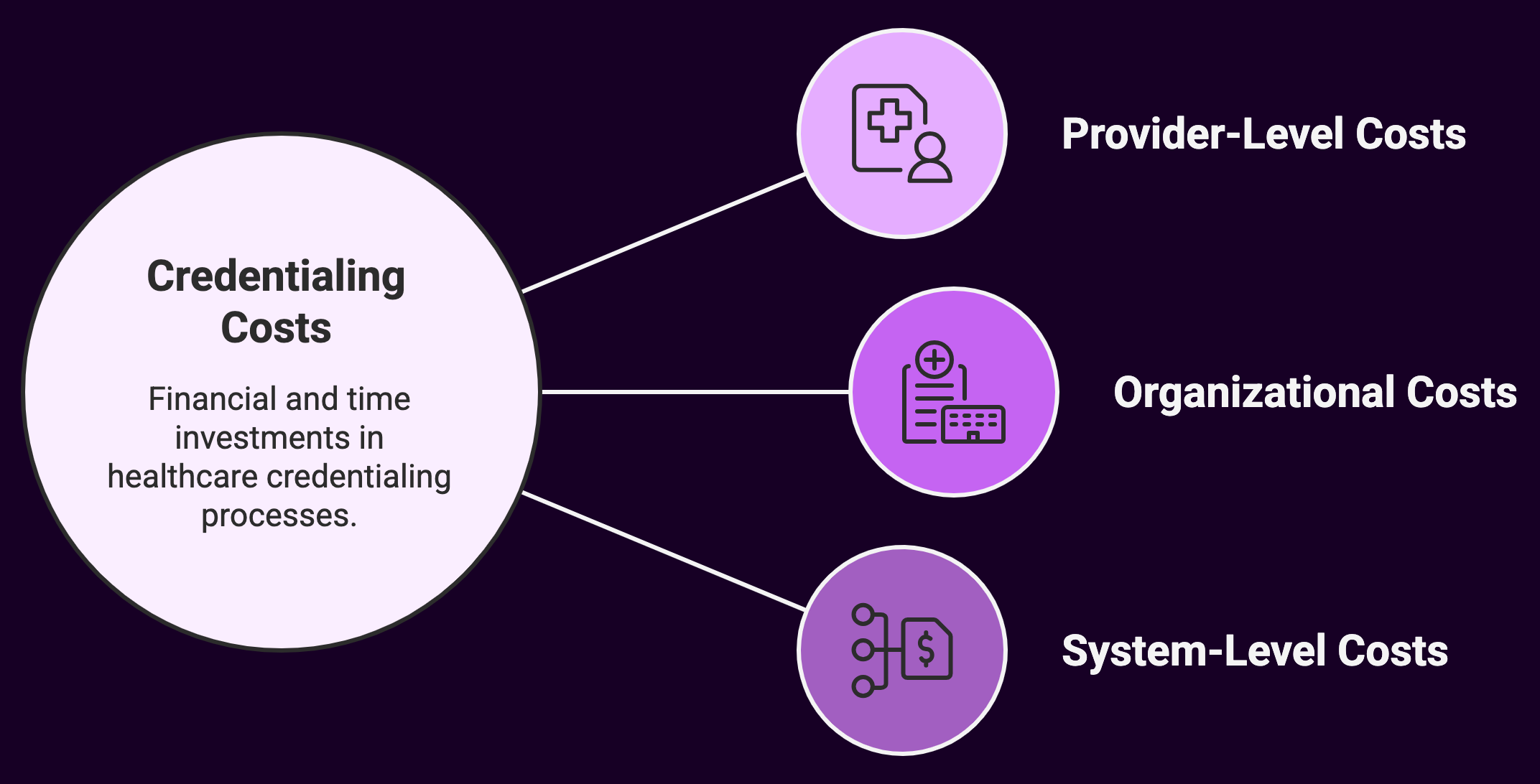Medical credentialing stands as a crucial yet often overlooked process that ensures patient safety and care quality. Behind the certificates hanging on providers’ walls lies an intricate system of verification, assessment, and ongoing monitoring that consumes significant resources within our healthcare system. Below, we discuss the economics of medical credentialing, examining its costs, resource implications, and potential avenues for optimization in an increasingly strained healthcare environment.
The Financial Burden: Direct Costs of Medical Credentialing

Provider-Level Costs
For individual healthcare providers, credentialing represents a significant financial investment beginning in medical school and continuing throughout their careers.
These expenses include:
 Initial certification costs: Board certification exams often cost between $1,200 and $2,000 per attempt, with additional preparation materials potentially adding thousands more.
Initial certification costs: Board certification exams often cost between $1,200 and $2,000 per attempt, with additional preparation materials potentially adding thousands more.- Maintenance of certification (MOC): Specialists may spend $2,000-$4,000 every 7-10 years to maintain board certification, plus ongoing costs for required continuing education.
- State medical licensure: Initial license application fees range from $200-$1,000 depending on the state, with renewal fees every 1-3 years.
- DEA registration: Prescribing controlled substances requires DEA registration at approximately $888 every three years.
- Time costs: Perhaps most significantly, providers spend countless hours completing applications, gathering documentation, and responding to verification requests—time that could otherwise be spent on patient care or personal well-being.
For a typical physician, these direct credentialing expenses can easily exceed $5,000-$10,000 every few years, not counting the opportunity cost of time spent on administrative requirements rather than clinical practice.
Organizational Costs
Healthcare organizations bear even greater financial burdens related to credentialing:
- Staffing costs: Medium-sized hospitals typically employ 3-5 full-time credentialing specialists at an annual cost of $50,000-$75,000 per employee, plus benefits.
- Technology investments: Credentialing software systems range from $20,000-$100,000 for initial implementation, with ongoing subscription and maintenance fees.
- Committee time: Medical staff committees composed of highly-compensated physicians must review applications and make recommendations, representing significant opportunity costs.
- Legal and compliance costs: Organizations must ensure their credentialing processes meet regulatory requirements and manage liability risks associated with negligent credentialing claims.
A 300-bed hospital might spend $350,000-$500,000 annually on credentialing-related activities, while larger health systems with thousands of affiliated providers can see these costs run into the millions.
System-Level Costs
At the healthcare system level, the inefficiencies of credentialing create additional burdens:
- Redundant verification processes: The same information is often verified repeatedly by different organizations.
- Delayed provider onboarding: Revenue losses occur when qualified providers cannot begin practice due to credentialing delays.
- Administrative overhead: Payers, hospitals, and regulatory agencies all maintain separate credentialing departments and systems.
These system-level inefficiencies contribute to the estimated $350 billion in annual administrative waste within U.S. healthcare.
The Hidden Costs: Beyond Financial Statements
Beyond direct financial expenditures, medical credentialing imposes several less visible but equally significant costs on healthcare delivery:
Provider Burnout Contribution
Administrative burden ranks among the top contributors to physician burnout. Surveys consistently show that paperwork and regulatory requirements, including credentialing activities, rank among providers’ greatest frustrations.
“The endless cycle of documentation requests, form completions, and attestations adds substantial stress to already demanding clinical careers,” notes Dr. Jonathan Wei, who studies physician well-being at the University of California. “When providers spend evenings and weekends completing credentialing applications instead of recharging or spending time with family, it takes a cumulative toll on their mental health and job satisfaction.”
This burnout contribution represents a hidden cost that ultimately affects patient care quality and healthcare workforce stability.
Care Delivery Delays
When credentialing processes drag on, patients suffer. Specialized care may be delayed while qualified providers await approval to practice. Rural and underserved communities particularly feel this impact when desperately needed providers cannot begin seeing patients due to credentialing backlogs.
In one documented case, a critical access hospital in rural Montana recruited a much-needed emergency physician but lost over $120,000 in potential revenue while waiting three months for the physician to complete the credentialing process with various payers.
Innovation Barriers
The resource-intensive nature of current credentialing systems can also impede healthcare innovation. New care models, telehealth initiatives, and cross-state provider mobility often face credentialing-related obstacles that slow implementation and increase costs.
Resource Allocation Challenges: Who Bears the Burden?
The costs of medical credentialing are not distributed equally across the healthcare ecosystem.
This uneven allocation creates additional challenges:
Provider Size Disparities
Large healthcare organizations can achieve economies of scale in credentialing by employing dedicated staff and implementing sophisticated systems.
In contrast, smaller practices and independent providers face disproportionate burdens:
- Small practices may spend 20-30 hours per provider on initial credentialing and 10-15 hours on recredentialing
- Independent providers often pay third-party credentialing services $500-$1,000 per application
- Rural healthcare facilities with limited administrative resources struggle with complex credentialing requirements
This disparity contributes to ongoing healthcare consolidation as independent practices find administrative burdens increasingly unsustainable.
Patient Cost Impact
While patients rarely see a line item for “credentialing” on their medical bills, they ultimately bear these costs through:
- Higher insurance premiums that cover payers’ administrative expenses
- Increased provider charges that incorporate administrative overhead
- Reduced access to care when credentialing delays affect provider availability
Studies suggest that administrative simplification, including streamlined credentialing, could reduce healthcare costs by 2-5%, translating to billions in potential savings that could benefit patients.
Optimization Opportunities: Rethinking Resource Allocation
Given the substantial resources consumed by current credentialing processes, several optimization opportunities deserve consideration:
Credentials Verification Organizations (CVOs)
CVOs provide centralized verification services, eliminating redundant efforts across multiple organizations. By conducting primary source verification once and sharing results with multiple entities that require the information, CVOs can significantly reduce system-wide resource consumption.
The expansion of CVO utilization could save an estimated 40-60% of verification costs across the healthcare system. However, challenges remain in establishing trust across organizations and creating sustainable funding models for these services.
Technology-Enabled Solutions
Emerging technologies offer promising avenues for resource optimization:
- Blockchain credentialing: Immutable distributed ledger systems could create verifiable, secure credential records that eliminate redundant verification processes.
- Artificial intelligence: AI-powered verification systems can automate document review, cross-referencing, and flagging of potential concerns for human review.
- Integration platforms: Systems that connect disparate credentialing databases can reduce duplicate data entry and verification requirements.
The healthcare technology firm Hashed Health estimates that blockchain-based credentialing solutions could reduce administrative costs by up to 70% while accelerating verification timeframes from weeks to minutes.
Regulatory Harmonization
The patchwork of state licensing requirements, payer-specific criteria, and facility-specific standards creates unnecessary complexity and resource waste.
Potential improvements include:
- Expanded interstate licensure compacts that reduce multi-state licensing burdens
- Standardized verification requirements across payers and healthcare facilities
- Aligned recredentialing cycles to minimize redundant verification activities
The Interstate Medical Licensure Compact, now adopted by over 30 states, represents a step toward this harmonization but addresses only a fraction of the overall credentialing burden.
Value-Based Credentialing
Perhaps most fundamentally, the healthcare system could benefit from transitioning toward value-based credentialing approaches that:
- Focus resources on high-risk areas rather than applying uniform verification requirements
- Incorporate quality and outcome measures alongside traditional qualification verification
- Implement progressive credentialing models where proven performance reduces verification burden
“We need to move from a ‘check-the-box’ mindset to a risk-stratified approach that directs resources where they matter most,” argues healthcare policy expert Dr. Samantha Rowen. “Not every credential requires the same level of scrutiny, and not every provider presents the same level of risk.”
The Future of Medical Credentialing: Balancing Protection and Efficiency
As healthcare faces intensifying resource constraints, the future of medical credentialing will likely involve difficult balancing acts between several competing priorities:
Safety vs. Efficiency
Patient protection remains the fundamental purpose of credentialing systems. Any resource optimization must maintain or enhance this protection while reducing waste. This requires thoughtful risk assessment rather than simply cutting corners.
Standardization vs. Specialization
While standardized processes can reduce administrative burden, credentialing requirements must also account for specialty-specific competencies and practice contexts. Finding the right balance between universal standards and specialty-specific requirements presents ongoing challenges.
Immediate Costs vs. Long-Term Benefits
Many promising credentialing innovations require significant upfront investment in technology, process redesign, and organizational change. Healthcare organizations must weigh these immediate costs against potential long-term resource savings.
Summary: Toward Responsible Resource Stewardship
Medical credentialing serves an essential function in healthcare quality and safety. However, its current resource footprint appears increasingly unsustainable in an era of healthcare cost containment and clinician burnout.
Moving forward, all healthcare stakeholders (providers, organizations, payers, and regulators) must collaborate to develop credentialing approaches that maintain rigorous quality standards while minimizing unnecessary resource consumption. This will require technological innovation, policy reform, and cultural shifts in how we approach provider qualification verification. The goal should not be to eliminate credentialing costs but to ensure that every dollar spent and every hour invested contributes meaningfully to healthcare quality and patient protection. Reimagine credentialing as an opportunity for responsible resource stewardship rather than merely a compliance requirement, the healthcare system can potentially redirect billions in resources toward what matters most: patient care.


 Initial certification costs: Board certification exams often cost between $1,200 and $2,000 per attempt, with additional preparation materials potentially adding thousands more.
Initial certification costs: Board certification exams often cost between $1,200 and $2,000 per attempt, with additional preparation materials potentially adding thousands more.